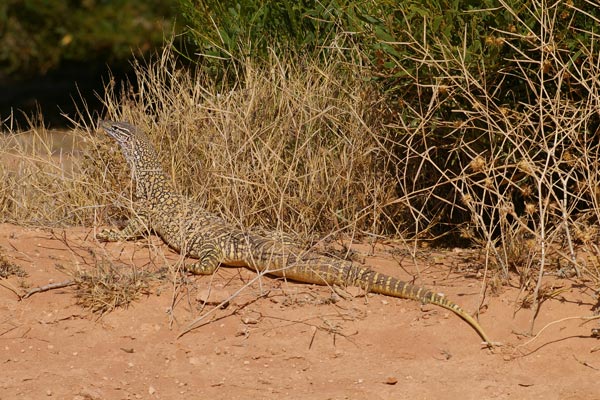 在2006年曾有一篇文章建議以測定血液中的雄雌激素比例在野外鑑識莫頓巨蜥的性別. 然而在巨蜥的實務飼養與管理上, 很多飼養者口頭相傳認為巨蜥"尾部何者較粗"可當作雌雄判別的依據. 也有人認為把巨蜥拿去照X-ray就應該可以分辨雌雄, 然而澳洲的研究指出若半陰莖骨化不明顯, 那麼在X-ray顯影下看不見半陰莖也不表示那一定是雌性. Smith et al. (2007)這篇文章便以澳州產的砂巨蜥Varanus gouldii (不是V. panoptes)進行檢測. 他們認為若這項檢測要能夠看到效果, 足夠的樣本數是一定要的(聽起來是廢話). 他們指出分辨雌雄最重要的形態測量特徵位於頭部以及四肢的比例, 然而沒有一個在過去被提出的統計模型預測可以用以區別受測巨蜥的性別. 也就是說每一個種類的統計模型很可能都是不一樣的, 若僅使用單一統計模型來檢測所有巨蜥的性別, 那麼誤差的機率是非常高的.
在2006年曾有一篇文章建議以測定血液中的雄雌激素比例在野外鑑識莫頓巨蜥的性別. 然而在巨蜥的實務飼養與管理上, 很多飼養者口頭相傳認為巨蜥"尾部何者較粗"可當作雌雄判別的依據. 也有人認為把巨蜥拿去照X-ray就應該可以分辨雌雄, 然而澳洲的研究指出若半陰莖骨化不明顯, 那麼在X-ray顯影下看不見半陰莖也不表示那一定是雌性. Smith et al. (2007)這篇文章便以澳州產的砂巨蜥Varanus gouldii (不是V. panoptes)進行檢測. 他們認為若這項檢測要能夠看到效果, 足夠的樣本數是一定要的(聽起來是廢話). 他們指出分辨雌雄最重要的形態測量特徵位於頭部以及四肢的比例, 然而沒有一個在過去被提出的統計模型預測可以用以區別受測巨蜥的性別. 也就是說每一個種類的統計模型很可能都是不一樣的, 若僅使用單一統計模型來檢測所有巨蜥的性別, 那麼誤差的機率是非常高的. 文獻來源: Smith JG, Brook BW, Griffiths AD, Thompson GG. 2007. Can Morphometrics Predict Sex in Varanids? Journal of Herpetology 41(1): 133-140. [全文連結]
Abstract
Varanid lizards are difficult to sex in the field because commonly used techniques are not completely reliable and definitive techniques are not logistically or economically feasible for many field-based applications. Previous work has shown that variation in morphometric variables can be used to determine sex in some species of varanid. Here we build on these previous exploratory analyses by developing a set of a priori models (containing morphometric variables) to predict the sex of six species of Australian varanid, and then examining their relative support under the information-theoretic framework. We then use cross-validation procedures to determine the reliability of the best-supported models' predictive ability. Our analysis suggests that a large sample size is required for building models to predict sex in many species. The most important sexually diagnostic features for many species were a number of head variables and (to a lesser extent) scaling of limb proportions. This analysis provides some useful statistical tools for the field-sexing of adult and juvenile Varanus gouldii with a known level of reliability and also serves to highlight the danger of extrapolating from potentially spurious results when using exploratory methods or null hypothesis testing.
圖片連結: wildherps.com
